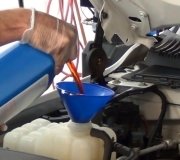The easiest on any car is to remove one heater hose from the engine, disconnect the lower radiator hose on one end, and remove the radiator cap. Run water from a garden hose into the heater hose, then into the fitting on the engine, then into the radiator. I never remove a heater hose from the heater core because the brass ones could be partially corroded and break the pipes loose from the stress of twisting the hose. GM cars especially have plastic pipes that we all know are designed to break and lead to an expensive heartache. The fittings on the engine are usually steel and won't break.
Be aware that on an old car like yours, (which isn't quite as old as my daily driver), they can have sediment settled in the heater core that is blocking a leak. If the core is paper-thin from corrosion, aggressive flushing can lead to it developing a leak you didn't have before.
I also never open radiator petcocks. There were some in the mid '90s that had plastic radiator tanks that would crack internally the first time the petcock was opened and from then on there would be a drip about once every five or ten seconds. The only fix was to replace the radiator. You likely won't run into that but the water is not going to run out through it as fast as you want to run it in. If you don't want to or can't get to the lower radiator hose, leave the cap loose while you're flushing so the water can run out the top of the radiator.
Don't forget to fill the reservoir repeatedly. On Chryslers you can disconnect the rubber hose from the radiator neck and hold it down so the water siphons itself out of the reservoir. If you can do that on your car you can clean it too. Then you can fill it again and keep doing that as much as you want to.
When you go to refill the system do not premix the water and antifreeze, and don't fall that stuff that's already premixed half and half. They're selling you half a gallon of water and only half a gallon of antifreeze for the same cost as a full gallon of antifreeze. Also, there is going to be a lot of fresh clean water stuck in the engine, left over from flushing, that won't drain out. If you pour in a 50 / 50 mix, that water is going to dilute it. Most of the cars I did took two gallons of coolant. Once all the water drained after the flush that was going to, I added one complete gallon of new antifreeze, then just enough water to fill the radiator. Some engines need to be burped to remove an air pocket under the thermostat. Some will do that automatically. Watch after you start the engine for signs it's starting to overheat. Don't let that happen.
Once the coolant is flowing the water and antifreeze will mix, then you can measure the freeze point. Based on that you will know to add more water or more antifreeze and the reservoir will be empty giving you room to add. Minus 35 degrees F. Is fine. That's about a 50 / 50 mix. Minus 50 degrees F. Is the best you can do. If you add more antifreeze the freeze point will actually start to go back up but if you're using a tester with a pointer or with little balls or discs that float, those will incorrectly indicate a lower freeze point. Those things measure the weight of the coolant compared to the weight of straight water. Antifreeze is much heavier than water so the balls will all float in straight antifreeze, but its freeze point without adding any water is around 0 degrees F. Antifreeze and water have to be mixed to achieve a freeze point that's lower than for either one by itself.
If you need to bleed the system, some will do that slowly if you just let it sit a while after the engine was warmed up. If you see a bleeder screw near where the upper radiator hose attaches to the engine, that is pretty obvious that it needs to be manually bled, and they gave you a means to do so. If there is no bleeder screw there will be a threaded plug or a temperature sensor nearby that can be removed. I prefer to remove sensors with the engine off and the ignition switch off. If the ignition switch is on a diagnostic fault code will be set if you unplug any sensor. Those will usually self-erase after a period of time but it's better to avoid setting it at all in case a real problem develops. Any fault codes that you cause will just confuse the issue.
Wednesday, May 15th, 2013 AT 10:04 PM



